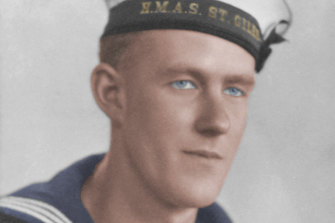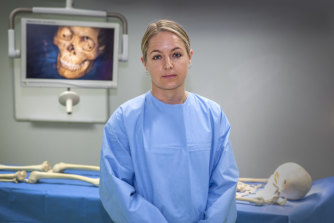For 70 years, Thomas Welsby Clark was an “unknown soldier”.
The only sailor whose body was found after the sinking of HMAS Sydney during World War II was finally identified last year after a new program linking unidentified human remains with long-term missing persons took on his case, did some further testing on samples of his remains, and found a descendent who matched.
The National DNA Program for Unidentified and Missing Persons was launched in 2020 with the goal of linking some of the hundreds of unidentified human remains with long-term missing persons. Initially allocated funding from proceeds of crime seizures for 2.5 years, the AFP on Thursday announced it will now be extended until the end of 2023.
A colourised studio portrait of Able Seaman Thomas Welsby Clark when he was an Ordinary Seaman on HMAS St Giles. Credit:Defence Images
Giving a name to the former “unknown soldier” has been one of the highlights of the program’s first two years, but Associate Professor Jodie Ward says there’s a lot more work to do, with hundreds of unknown persons whose body parts have been found across Australia – as well as forensics gaps in long-term missing persons cases that she’s endeavouring to fill in by gathering data like dental records and reference DNA samples from family members.
So far, 55 sets of remains have been examined under the program, with 36 submitted for specialist DNA testing. Five have been matched with missing persons. But the most recent national case audit reported 750 sets of unidentified human remains.
Ward advocated for a program of this kind for nearly a decade after she first learned of the “hundreds” of human remains sitting unidentified in forensic and mortuary facilities around the country, which had been subjected to “a variety of tests in some cases and no testing at all in others” – largely due to the different forensic capabilities of different states and territories.
She saw the need for a centralised national facility with the sole focus of examining these human remains, and providing a suite of forensic tools that could be used to solve them.
Associate Professor Jodie Ward, head of the program.
Ward hopes the 12-month extension will give the team a chance to clear some more of the backlog of very old cases, and ensure that the system is in top shape for identifying future discoveries of human remains.
“We want to ensure that everything is in place so that we can bring remains that are discovered [and] provide those answers back to the families as efficiently and effectively as we can, now that we have new forensic techniques [and] new forensic databases,” she said.
In the case of Thomas Welsby Clark, a partial DNA profile was obtained when his remains were exhumed in 2006, but it wasn’t until further DNA testing was carried out on the sample with the latest technology that a match was made with a male descendent last year, proving his identity.
Ward is excited about new capabilities that the program will soon utilise, like cranio-facial reconstruction, where a 3D scan is taken of a skull and then forensic artists build up surface details on the face to show what the person may have looked like. Previously only available offshore, she says the Australian program will incorporate this technology within the next two months.
Samples have also been sent off to the US for forensic genealogy testing, Ward said, and the team is trying to implement a similar process in Australia so that doesn’t have to be outsourced.
“We want every set of remains in Australia to be subjected to the best types of testing and ensure they are all being treated equally,” she said.
As well as improving what’s possible for every set of Australian remains already found, Ward says having the database also promotes best practices when it comes to new missing persons investigations, and will help to ensure as much data is already at hand to use when new technology arrives.
Ultimately, the success of the program relies on families of missing persons providing police and forensic investigators with vital information, records and samples for comparison. Which means that time is of the essence, especially in cases that are decades old.
The Morning Edition newsletter is our guide to the day’s most important and interesting stories, analysis and insights. Sign up here.
Most Viewed in National
From our partners
Source: Read Full Article
-
Bruised biker leaves note offering £100 to find 'b*****d' driver
-
Belarus floats terrifying axis with Russia and North Korea
-
Dramatic moment banned BMW driver goes off-road and still avoids jail
-
DAILY MAIL COMMENT: Now Boris is facing a kangaroo court
-
Putin’s 300,000 new recruits face horror carb-filled diet on the frontline



